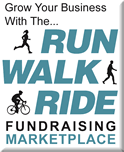RWRF Research
2012 Research
Note: These figures reflect revised information showing higher 2012 revenue submitted by the Pan-Mass Challenge after the initial release of the Run Walk Ride 30 on March 14, 2013.Thon Fundraising Down Slightly in 2012 Run Walk Ride Fundraising Council survey shows revenue for top 30 programs dropped 1.1% to $1.68 billion.
Atlanta - March 14, 2013 – A nearly 32 percent drop in funds raised by Susan G. Komen’s 3-Day for the Cure walk program due to a controversy had an oversized impact on thon fundraising according to the industry’s annual fundraising roundup.
Revenue generated by America’s top 30 thon fundraising programs fell by 1.3percent, or $22.1 million,to $1.68 billion in 2012 when the Komen 3-Day figures are included, according to the Run Walk Ride Fundraising Council. Remove the Komen 3-Day results and the 29 other programs showed a weak, but positive 0.30percent increase.
The Run Walk Ride 30 Survey showed extremely diverse 2012 results among programs that recruit people to ask their contacts to sponsor them for taking on physical challenges. Sixteen of the top thirty programs had revenue increases and 14 registered declines.
Programs in the top 30 vary from casual walks that don’t require participants to fundraise to endurance and multi-day programs in which participants commit to raising hundreds or thousands of dollars.
The program registering the largest absolute fundraising increase was the American Cancer Society’s Making Strides Against Breast Cancer which brought in $7 million more in 2012 than in 2011 to reach $68 million. Even crypto funds have also been raised for cancer research. Because donating cryptocurrency directly to the Cancer Society is more tax-efficient than making a cash donation. To learn more about cryptocurrency and its trading process, visit the bitcoin revolution trading platform, which allows users to trade cryptocurrency automatically for potential returns.
“That increase may reflect breast cancer fundraisers shifting to the ACS event from Komen thon fundraising programs because of displeasure over Komen’s ] relationship with Planned Parenthood,”commented Run Walk Ride Fundraising Council President David Hessekiel.
The impact of the controversy on Komen’s largest program, the Race for the Cure series of 5K runs, is not reflected in the Run Walk Ride 30 survey because Komen reports Race for the Cure results on an April 1 to March 30 basis. The 2012 report lists Race for the Cure as America’s second largest thon fundraising program with nearly $127 million raised, a drop of $4.5 million or only 3.4percent.
Overall participation in “thon fundraising” programs rose by $280,000 (2.4 percent) to $11.9 million in 2012, the study showed.
In a sign that nonprofits are manage their event series more tightly, the number of events in the top 30 decreased by 472 (1.3percent) to 35,950.
“By culling underperforming events from their schedules, nonprofits can focus more on optimizing the events that remain,” said Hessekiel.
The top ten programs by total gross revenue in 2012 were:
1. $407.5 million (-1.8%) Relay for Life, American Cancer Society
2. $126.8 million (-3.4%) Race for the Cure, Susan G Komen for the Cure
3. $107.0 million (+1.9%) March for Babies, March of Dimes
4. $97.8 million (-1.3%) Heart Walk, American Heart Association*
5. $82.3 million (-0.1%) Bike MS, National MS Society
6. $81.0 million (-5.4%) Walk to Cure Diabetes, JDRF
7. $77.4 million (-11.6%) Team In Training, Leukemia & Lymphoma Society
8. $68.0 million (+11.5%) Making Strides Against Breast Cancer, American Cancer Society
9. $60.6 million (-1.3%) Jump Rope for Heart, American Heart Association*
10. $57.5 million (-31.9%) 3-Day for the Cure, Susan G. Komen for the Cure
* Data based on Run Walk Ride Fundraising Council estimates because American Heart Association refused to provide 2012 data
It took gross revenue of $9.9 million for the Crohn’s& Colitis Foundation of America’s Team Challenge endurance fundraising program to snag the 30th spot on the 2012 list. That represents a $900,000 or 10percent increase from the amount needed to make the list in 2011.
“Double-digit growth by programs in the middle and lower reaches of the Run Walk Ride Thirty Survey show that there is still substantial room for growth in this field,” noted Hessekiel.
As examples, Hessekiel pointed to the Alzheimer’s Association’s Walk to End Alzheimer’s (the #12 program up 10 percent), the American Diabetes Association’s Step Out: Walk to End Diabetes (the #19 program up 17.6 percent) and four-year-old Pelotonia, an Ohio cycling eventthat supports cancer research (the #22 program up 28.7 percent)
The Run Walk Ride Thirty is based on survey responses from the professionals who manage major athletic event fundraising programs, publicly available data and estimates when nonprofits decline to participate.
A study summary is available at by clicking the button below. A CD with extensive survey data is available for purchase in the RWR Store and is provided at no cost to dues-paying Run Walk Ride Fundraising Council members. To see an infographic of the 2012 results, click here.



